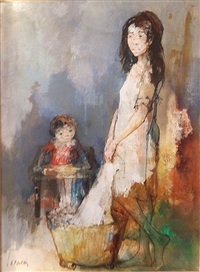Երգահան
Ալեքսանդր Յարութիւնեան ծնած է Երեւան, Սեպտեմբեր 23, 1920ին։ Հայրը՝
Գրիգոր Յարութիւնեան, զինուորական մըն էր։ Մտած է Երեւանի պետական
երաժշտանոցի մանկական խումբը 1927ին, իսկ 1934ին ընդունուած՝ երաժշտանոցը,
ուրկէ շրջանաւարտ եղած է Բ. Աշխարհամարտի նախօրեակին։ 1941ին գրած է առաջին
գործը՝ “Impromptu”, թաւջութակի եւ դաշնակի համար։ Պատերազմէն ետք
փոխադրուած է Մոսկուա, մասնակցելով Հայ Մշակոյթի Տան աշխատանոցներուն մէջ
(1946-1948), Մոսկուայի երաժշտանոցին մէջ ուսանած շրջանին, զոր աւարտած է
1948ին։
1949
ին
Յարութիւնեան շահած է «Ստալին» մրցանակը «Հայրենիք» քանթաթին համար, զոր
գրած էր երբ կ՚ուսանէր Մոսկուայի երաժշտանոցը։ Միեւնոյն տարին, ան յօրինած է
«Տօնական» նախաբանը, իսկ յաջորդ տարին՝ «Հայկական ռապսոդիա»ն (Առնօ
Բաբաջանեանի հետ)։ 1950ին ամուսնացած է Իրինա (Թամարա) Օտենովայի հետ եւ
երկու զաւակ ունեցած։
 Վերադառնալով
Երեւան, 1954-1991ին Յարութիւնեան Հայֆիլհարմոնիայի գեղարուեստակնան
ղեկավարն էր։ Անոր գործերուն գնահատանքը շարունակուած է։ Անոնցմէ շատեր
ներշնչուած են հայ երաժշտութեան ժողովրդական աւանդութիւններէն, ինչպէս «Ասք
հայ ժողովրդի մասին» (1961) երգային համանուագային պոէմը։ 1960ական
թուականներուն Յարութիւնեան հակած է դասական ձեւերու եւ աւելի յստակ
հնչերանգներու։
Վերադառնալով
Երեւան, 1954-1991ին Յարութիւնեան Հայֆիլհարմոնիայի գեղարուեստակնան
ղեկավարն էր։ Անոր գործերուն գնահատանքը շարունակուած է։ Անոնցմէ շատեր
ներշնչուած են հայ երաժշտութեան ժողովրդական աւանդութիւններէն, ինչպէս «Ասք
հայ ժողովրդի մասին» (1961) երգային համանուագային պոէմը։ 1960ական
թուականներուն Յարութիւնեան հակած է դասական ձեւերու եւ աւելի յստակ
հնչերանգներու։
Երգահանը
գրած է 13 համերգներ տարբեր գործիքներու համար։ 1950ի շեփորի համերգը զինք
ծանօթ անուն դարձուցած է Միացեալ Նահանգներու մէջ։ 1988ին յօրինած է
«Հայաստան-88» համերգը ջութակի եւ լարային նուագախումբի համար, որ
ներշնչուած էր Սպիտակի երկրաշարժէն։
Գրած
է նաեւ «Սայաթ-Նովա» օփերան, օգտագործելով մեծ աշուղի երգերէն մէկ քանին
(1968), «Հայրենիքիս հետ» երգ-քանթաթը՝ ըստ Յովհաննէս Թումանեանի
բանաստեղծութիւններուն (1969) եւ «Յուշարձան մայրիկիս» շարքը՝ ըստ
Յովհաննէս Շիրազի բանաստեղծութիւններուն (1969)։
Անոր
բեղուն արտադրութիւնը կ՚ընդգրկէ թատրոնի եւ շարժապատկերի երաժշտութիւն,
ներառեալ «Սիրտը երգում է» (համահեղինակ՝ Կոստանդին Օրբելեան, 1956) եւ
«Նահապետ» (1977) ֆիլմերը։
Ալեքսանդր
Յարութիւնեան 1962ին Հայաստանի ժողովրդական արուեստագէտի, իսկ 1970ին՝
Խորհրդային Միութեան ժողովրդական արուեստագէտի տիտղոսները ստացած է։ 1970ին
եւս սկսած է դասաւանդել «Կոմիտաս» երաժշտանոցին մէջ (Երեւանի պետական
երաժշտանոց)։ Փրոֆեսորի տիտղոսը ստացած է 1977ին եւ շարունակած աշխատիլ՝
մինչեւ 2008։ Անկախութենէն ետք ալ, ան պարգեւուած է մետալներով եւ
շքանշաններով։ 1987ին Երեւանի պատուաւոր քաղաքացիի տիտղոսը ստացած էր։
Շարունակած է արտադրել մինչեւ իր վերջին տարիներր։ Վերջին գործը «Երեխաների ալպոմ»ն էր՝ դաշնակի համար (2004)։
Ալ. Յարութիւնեան իր մահկանացուն կնքած է 28 Մարտ, 2012ին, Երեւանի մէջ։ Թաղուած է Կոմիտասի անուան պանթէոնին մէջ։








